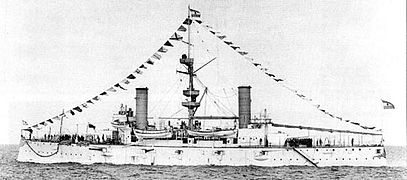|
Giuseppe Garibaldi-class cruiser
The Giuseppe Garibaldi-class cruisers were a class of ten armoured cruisers built in Italy in the 1890s and the first decade of the 20th century. The ships were built for both the Royal Italian Navy (Regia Marina) and for export. The class was named for Italian unifier and nationalist Giuseppe Garibaldi. Design and description The design of the Giuseppe Garibaldi-class cruiser was derived by the naval architect Edoardo Masdea from his earlier Vettor Pisani-class design. The Garibaldis were slightly larger and about a knot faster than their predecessors, but the primary improvement was the addition of two gun turrets, one each fore and aft of the superstructure. These remedied a major weakness of the older ships in that their primary armament, being on the broadside, could not engage targets that were directly in front or behind. The design was so popular that ten cruisers were purchased by four different countries; the Royal Italian Navy, the Argentine Navy, the Imperial Japanese Navy, and the Spanish Navy. As might be expected over a group of ships that was built from 1892 to 1903, design improvements and more modern equipment were incorporated over time so that only the three ships actually accepted by Italy were true sisters.[1] The first five ships were built to the same measurements, and form the Garibaldi sub-class, but the last five were stretched by six frames amidships, and comprise the Giuseppe Garibaldi sub-class. The ships of the first group had an overall length of 106.94 meters (350 ft 10 in), a beam of 18.2 meters (59 ft 9 in) and a deep draft (ship) of 7.1 meters (23 ft 4 in). They displaced 6,840 metric tons (6,730 long tons) at normal load.[2] The second ship purchased by Argentina, General Belgrano, is reported by some sources to have had a beam of 18.8 meters (61 ft 8 in) and therefore displaced some 300–400 metric tons (300–390 long tons) more than the others.[3][4] The class was unusual in that they did not have a uniform main armament. Some had single 10-inch (254 mm) Elswick Pattern R guns in gun turrets fore and aft; others (including Kasuga) had a mixed armament of a single 10-inch (254 mm) gun in one turret and another turret with twin 8-inch (203 mm) guns. A third variation (including Nisshin) was a uniform armament of four 8-inch (203 mm) guns in twin gun turrets fore and aft. Cristobal Colon was fitted with 10-inch guns which the Spanish admiralty claimed were defective and which were removed before it was committed to combat. Therefore, it only went to battle with 10 smokeless powder Armstrong six inch guns mounted in the hull (5 on each side). ShipsAll ships were built by Gio. Ansaldo & C. in Genoa-Sestri Ponente, except ARA San Martin and ARA Belgrano which were subcontracted to Orlando in Livorno.
Construction and serviceIn addition, Spain was planning to acquire a second Garibaldi-class cruiser, to be named Pedro de Aragon. These plans were shelved after the Spanish–American War and the subsequent downsizing of the Spanish Armada. Two of the Italian ships ordered in 1902 were sold to the Argentine Navy before completion as the Mitre and Roca; they were renamed as the Rivadavia and the Mariano Moreno. The Argentines in turn sold them to the Imperial Japanese Navy before final completion in 1904, and they were renamed the Kasuga and Nisshin. Gallery
NotesBibliography
External linksWikimedia Commons has media related to Giuseppe Garibaldi class cruiser.
|
||||||||||||||||||||||||||||||||||||||||||||||||||||||||||||||||||||||||||||||||||||||||||||||||||||||||||





